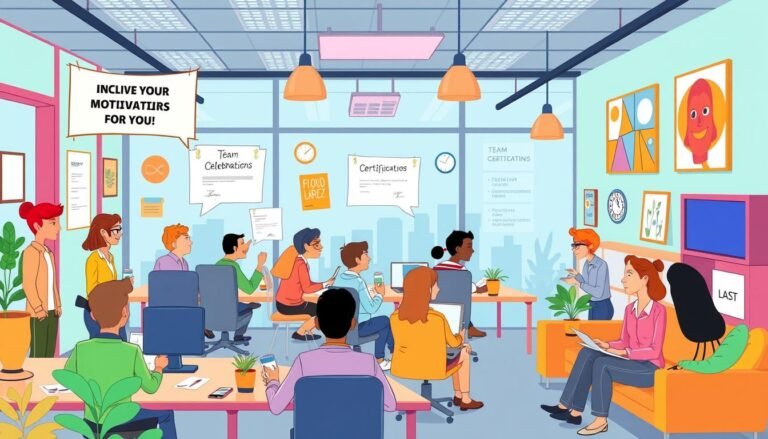Transforming Corporate Culture: The Psychological Approach to Sustainable Change
Can a company’s culture really be the key to success? This question has sparked debates in boardrooms and academic circles. In today’s fast-paced business world, changing corporate culture is more than just a buzzword. It’s a critical factor in how organizations change and work together.
Imagine a workplace where every employee is not just engaged, but truly invested in the company’s mission. This isn’t a pipe dream. It’s the power of a well-aligned corporate culture. Research shows that 91% of executives believe improving organizational culture directly increases company value. Yet, only a third say their culture fully aligns with their business strategy.
The challenge lies in changing a company’s DNA—its values, assumptions, and behaviors. It’s a complex process that requires addressing mindsets, abilities, structures, and systems. But when done right, the rewards are substantial. Companies with strong, strategy-aligned cultures often outperform their competitors.
So, how can organizations navigate this tricky terrain of cultural change? The answer lies in understanding the psychology behind organizational behavior and employing strategies that tap into human nature. From addressing cognitive biases to leveraging positive psychology, the path to sustainable change is paved with insights from behavioral science.
Key Takeaways
- Corporate culture significantly impacts company value and performance
- Only a third of executives report full alignment between culture and strategy
- Effective transformation requires changes in mindsets, abilities, and systems
- Understanding psychology is crucial for successful organizational change
- Employee engagement is a key factor in cultural transformation
- Behavioral science insights can guide sustainable change strategies
Understanding the Psychology of Corporate Culture
Corporate culture affects how employees think, feel, and act. It’s key to understand its psychological side to make effective changes and boost engagement.
The Power of Mindsets in Change Management
Mindsets are crucial in change management. About 70% of organizational changes fail because of employee resistance. This shows the importance of being open to change and aligning with cultural values.
Cognitive Dissonance and Change Resistance
Cognitive dissonance can cause resistance to change. When new ideas clash with old beliefs, adapting becomes hard. Leaders must create a supportive space for change readiness.
Growth Mindset vs. Fixed Mindset
A growth mindset is essential for cultural change. Companies that support learning and growth see more employee growth. This mindset promotes adaptability and resilience, vital for change.
| Mindset Type | Characteristics | Impact on Change |
|---|---|---|
| Growth Mindset | Embraces challenges, learns from criticism | Increases change readiness, boosts engagement |
| Fixed Mindset | Avoids challenges, sees effort as fruitless | Resists change, hinders cultural transformation |
Understanding these psychological factors helps leaders manage change smoothly. This approach improves readiness for change and boosts employee engagement and cultural values alignment.
The Human Element in Organizational Change
Organizations are made up of people, each with their own way of reacting to change. It’s important to understand these reactions to succeed in workplace dynamics. Emotional, cognitive, and behavioral reactions are key in facing change resistance.
Keeping employees engaged is vital during changes. A study showed that 91% of executives believe better corporate culture boosts value. This shows how crucial the human side is in change efforts.
The Kübler-Ross Change Curve offers insights into typical reactions to change. It helps leaders prepare and address concerns, making the transition smoother.
“Engaging employees by making them feel involved, essential, and supported during organizational transformations increases the likelihood of success.”
For change to last, people must adopt new behaviors. Focusing on employee mindsets is critical. Companies that do this well often see better results:
- Increased productivity by aligning personal goals with company goals
- Improved teamwork and communication
- Enhanced problem-solving and innovation
- Lower turnover rates
By meeting interpersonal needs and building an inclusive culture, organizations can achieve lasting change. This approach boosts trust, engagement, and adaptability in the face of change.
| Aspect | Impact on Change Management |
|---|---|
| Employee Engagement | 91% of executives link it to increased organizational value |
| Teamwork | Improved collaboration and faster time to market |
| Innovation | Encouraged through valuing diverse perspectives |
| Turnover Rates | Lowered by addressing interpersonal needs |
| Organizational Culture | Enhanced by fostering inclusivity and trust |
Overcoming Psychological Barriers to Change
Change resistance is a big challenge in making organizations better. More than two-thirds of change efforts fail, often because employees resist. It’s key to understand the psychological barriers to succeed.
Loss Aversion and the Endowment Effect
People often value what they have more than new things. This can stop change efforts. Leaders need to show the benefits of change and support employees through it.
Anchoring and Confirmation Bias
Employees might stick to old ways, looking for reasons to believe in them. To beat this, leaders should talk openly and show solid reasons for change.
Addressing Employee Fears and Concerns
Fear of the unknown is a big reason for resistance to change. A study in Pakistan found that not getting everyone on board can lead to less engagement and more resistance. To tackle this:
- Give clear info about the change
- Make a supportive place
- Let employees help decide
Good communication is crucial. Bad change talks can make 73% of employees stressed, hurting their work by 5%. By facing fears and boosting engagement, companies can beat these barriers and make change work.
| Factor | Impact | Solution |
|---|---|---|
| Poor Communication | 73% employee stress | Clear, frequent updates |
| Lack of Buy-in | Reduced engagement | Involve employees in process |
| Change Fatigue | Decreased engagement | Pace changes, celebrate wins |
Corporate Culture Transformation: Strategies for Success
Changing a company’s culture is key to success. Companies with strong cultures have 20% higher ratings from employees. This shows how important leadership and communication are in changing a culture.
One important strategy is to engage employees. In strong cultures, 86% of employees feel heard by leaders, compared to 70% in weaker cultures. This makes employees more confident in their leaders, with 90% trusting them in winning cultures.
Changing a culture involves four main areas: mindsets, abilities, structures, and systems. Companies need to find gaps, define key practices, and create paths for growth. This can lead to big wins, like Unilever Brazil’s 11% revenue increase after changing its culture.
| Element | Description | Impact |
|---|---|---|
| Mindsets | Shifting employee attitudes and beliefs | 50% increase in productivity for valued employees |
| Abilities | Developing new skills and competencies | Improved adaptability to market changes |
| Structures | Reorganizing teams and departments | Enhanced collaboration and efficiency |
| Systems | Updating processes and technologies | Streamlined operations and decision-making |
But, only 12% of companies reach their culture change goals. This shows the need for detailed plans that include leadership, communication, and employee engagement. These are crucial for successful change in a company.
The Role of Leadership in Cultural Change
Leaders play a big role in shaping a company’s culture. They do this through their actions and decisions. A study found that companies that focus on culture are more likely to succeed in digital transformation.
Leading by Example: Modeling Desired Behaviors
Leaders must live the culture they want to create. When they do, their team is more likely to follow. This boosts engagement by 29% and pride by 27%.
Creating a Vision for Change
A clear vision is essential for change. Leaders who explain the purpose of their team’s work see a big jump in quality work. Being open about the company’s goals leads to a 87% increase in great work.
Empowering Employees Through Change
Empowering employees is crucial for cultural change. Leaders who support their team’s growth see a 39% increase in opportunities. Offering coaching boosts great work by 133%.
| Leadership Action | Impact on Employees |
|---|---|
| Acknowledging great work | 35% increase in feeling supported |
| Clarifying work meaning | 21% increase in discretionary effort |
| Recognizing small wins | 83% increase in engagement |
Good leaders create a culture of innovation and inclusivity. By focusing on these areas, companies can overcome resistance to change. This leads to a lasting, thriving culture.
Communication Strategies for Effective Change Management
Communication is key to successful change management. A survey shows 63% of people think internal communication is effective during changes. This highlights the need for clear messages to engage employees and prepare them for change.
It’s important to tailor messages for different groups. Leaders should use various channels and adjust their tone to connect with everyone. Being open builds trust, a vital part of communication. In fact, 60% see communication and participation as important in overcoming change resistance.
Good communication raises awareness, understanding, and trust. A solid communication plan should have:
- Clear goals
- Messages tailored for each group
- Effective ways to share information
- A set timeline
- Ways to get feedback
Using stories and narratives helps in change communication. They make messages relatable, touch emotions, ensure clarity, and fit with the change plan. Visual and digital tools like infographics, videos, and interactive sites also help.
| Communication Element | Importance | Impact on Change |
|---|---|---|
| Internal Communication | 30% of employees rate as critical | Drives employee engagement |
| Transparent Communication | Essential for overcoming resistance | Builds trust and understanding |
| Tailored Messaging | Crucial for engagement | Increases message effectiveness |
By using these communication strategies, organizations can boost their change management. This leads to more engaged employees and better readiness for change.
Measuring and Sustaining Cultural Transformation
Changing a company’s culture is a big job. It takes a lot of work and money. To do well, companies must track their progress and keep the change going.
Key Performance Indicators for Cultural Change
Measuring cultural change involves numbers and feelings. Companies use Key Performance Indicators (KPIs) to see how they’re doing. These help link culture changes to goals like making more money.
Continuous Improvement and Adaptation
Changing a company’s culture is never done. Companies should keep checking their culture with tools like the Organizational Culture Assessment Instrument. They should also talk to employees and check how they feel to see if changes are working.
Celebrating Milestones and Successes
It’s important to celebrate when things go well. Companies with strong cultures do better. They make more money, keep employees longer, and work more efficiently.
- 4x increase in revenue growth
- 31% lower turnover rate
- 12% increase in employee productivity
By celebrating, companies can keep their employees happy and engaged. This makes the culture stronger and helps the company keep improving.
Leveraging Positive Psychology in Organizational Change
Positive psychology is key in changing how workplaces work. It aims to build positive feelings, engagement, and success. This makes a great space for change to happen.
The PERMA model is a big part of positive psychology. It talks about five important things for well-being: Positive Emotion, Engagement, Relationships, Meaning, and Accomplishment. Using this model at work can make employees happier and more productive.
Employee engagement is like being in a flow state. It makes work more enjoyable and boosts productivity. Companies that make work meaningful see more loyalty and less turnover.
- Positive emotions enhance resilience and health
- Engagement boosts productivity and passion
- Meaningful work experiences increase commitment
- PERMA model improves overall workplace well-being
Adding positive psychology to change plans helps companies grow. It makes changes smoother and helps everyone feel good about their work.
Conclusion
Changing a company’s culture is complex but vital for lasting change. It needs a deep understanding of how people think and act. Companies that get it right often see big improvements.
Squarespace grew from 30 employees in 2010 to 1,800 by 2022. 94% of staff are happy with their jobs. This shows the impact of a good company culture. HubSpot also shows the value of investing in employees, with its 128-slide Culture Code and free development programs.
Netflix, Microsoft, and Zappos show that lasting change comes from more than just direct actions. It’s about aligning work processes and governance with goals. Remember, 56% of employees value company culture more than salary, showing its key role in success.
In short, changing a company’s culture is a long-term effort. It needs patience, dedication, and a readiness to change. By focusing on people and aligning structures with goals, companies can achieve lasting success and employee happiness.
Source Links
- Cultural Transformation
- A Strategic Leader’s Guide to Transforming Culture in Large Organizations
- How to Get Beyond Talk of “Culture Change” and Make It Happen
- Why Workplace Culture Matters – Professional & Executive Development | Harvard DCE
- The Psychology Behind Corporate Culture Change
- What Is Organizational Culture and Why Is It Important?
- The 4 elements of organizational culture transformation
- Organizational Change Management Guide for Developing Innovators & Leaders
- The Human Element: Applying FIRO Theory by Dr. Will Schutz for Enhanced Interpersonal Relations
- 11 Barriers to Organizational Change (+How to Overcome Them)
- The Psychology of Resistance to Change: The Antidotal Effect of Organizational Justice, Support and Leader-Member Exchange
- Leading a Successful Cultural Transformation at Your Organization
- 7 Steps To Facilitate A Successful Cultural Transformation | Harver
- Why Every Executive Should Be Focusing on Culture Change Now
- The Role of Leadership in Changing Organizational Culture
- How Does Leadership Influence Organizational Culture?
- Mastering Culture Change Management: A Comprehensive Guide
- Leading Through Change: Communication Strategies for Organizational Transformation | Park University
- Hospital organizational change: The importance of teamwork culture, communication, and change readiness
- How to Measure Culture Change: 8 Methods for Your Business
- Leading A Successful Culture Transformation for Organisational Growth | Culture Shift
- iOffice
- Change Management: The Art of Positive Change
- Positive Psychology In The Workplace: 16 Practical Tips
- Fostering a Positive Workplace Culture: Impacts on Performance and Agility
- 7 Organizational Culture Change Examples – TestGorilla
- 7 Inspiring Examples of Company Culture Transformation – Chris Dyer Keynote Speaker
- To Change Your Company’s Culture, Don’t Start by Trying to Change the Culture







